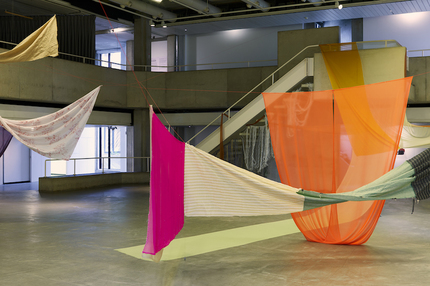
- Source: Artforum
- Author: Caoimhín Mac Giolla Léith
- Date: April 29, 2022
- Format: Online
Eric N. Mack
THE DOUGLAS HYDE GALLERY OF CONTEMPORARY ART

View of “Scampolo!,” 2022. Photo: Denis Mortel.
Known for formally agglutinative, strikingly hued, large-scale three-dimensional works composed of stained or dyed fabric and sometimes augmented by small objects and found photographs, Eric N. Mack prefers his art to be construed within the expanded field of painting. While this suggests an intriguing set of antecedents, from Robert Rauschenberg’s “Jammers” to the draped canvases of Sam Gilliam, viewers of this particular exhibition are required to negotiate it as they would an immersive installation. Titled “Scampolo!,” the Italian word for “remnant,” the show was born of an invitation to produce new work in response to the gallery’s late-’70s Brutalist architecture, as well as its surrounding context. Much of the fabric used was locally sourced from Emblem Weavers, one of the last remaining linen makers in a country that was once, in the late eighteenth century, the world’s biggest linen producer.
Visitors to the Douglas Hyde are typically offered a panoramic view of any given exhibition from a mezzanine entrance where they may linger a while before descending, at their chosen pace, into the sizable gallery via open staircase. Mack’s work is predicated on the movement of bodies through space, on minute shifts in vantage. So it is unsurprising that he should choose this staircase as a nexus from which to elaborate a habitat that seems at once precarious and resplendent, makeshift and carefully thought through. To tether, to drape, to heap, to stretch, to attach, to suspend. The variety of formal maneuvers deployed are matched by an equally notable range of real-world reference points: ship’s rigging, temporary shelter, festive bunting, wayside shrine, mood board, fashion spread. (The artist’s credentials in the latter regard include previous collaborations with designers Grace Wales Bonner and Kiko Kostadinov.) To navigate the show’s delicately delineated but porous quadrants requires a constant—and repeatedly rewarded—recalibration of one’s most immediate physical surroundings and proximate visual stimuli.

